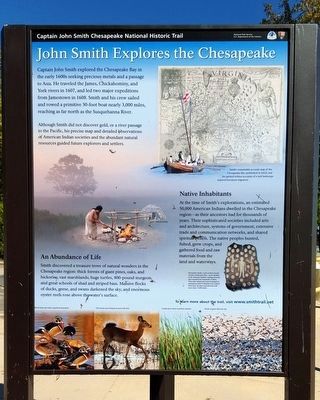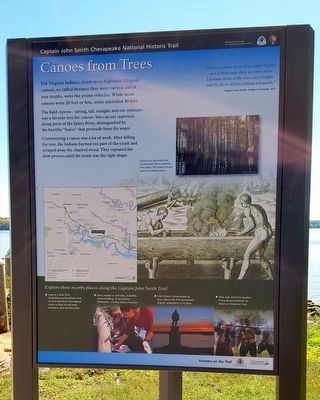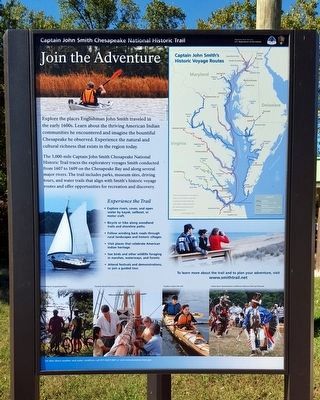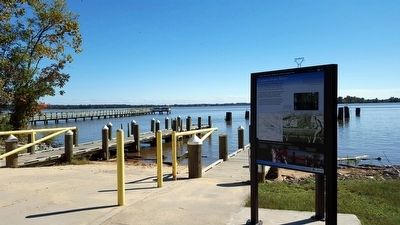Charles City in Charles City County, Virginia — The American South (Mid-Atlantic)
John Smith Explores the Chesapeake
Captain John Smith Chesapeake National Historic Trail
(panel 1)
John Smith Explores the Chesapeake
Captain John Smith explored the Chesapeake Bay in the early 1600s seeking precious metals and a passage to Asia. He traveled the James, Chickahominy, and York rivers in 1607, and led two major expeditions from Jamestown in 1608. Smith and his crew sailed and rowed a primitive 30-foot boat nearly 3,000 miles, reaching as far north as the Susquehanna River.
Although Smith did not discover gold, or a river to the Pacific, his precise map and detailed observations of American Indian societies and the abundant natural resources guided future explorers and settlers.
Native Inhabitants
At the time of Smith's explorations, an estimated 50,000 American Indians dwelled in the Chesapeake region—as their ancestors had for thousands of years. Their sophisticated societies included arts and architecture, systems of government, extensive trade and communication networks, and shared spiritual beliefs. The native people hunted, fished, grew crops, and gathered food and raw materials from the land and waterways.
An Abundance of Life
Smith discovered a treasure trove of natural wonders in the Chesapeake region: thick forests of giant pines, oaks, and hickories; vast marshlands, huge turtles, 800-pound sturgeon, and great schools of shad and striped bass. Massive flocks of ducks, geese, and swans darkened the sky; and enormous oyster reefs rose above the water's surface.
To learn more about the trail visit www.smithtrail.net
(captions)
Smith’s remarkably accurate map of the Chesapeake Bay (published in 1612), and his spirited written accounts of a lush landscape inspired European migration.
Decorative shells-such as those found on this ceremonial robe-were valuable in the American Indian’s trading network that extended for hundreds of miles. This robe (which may have belonged to paramount chief Powhatan) was crafted from four elk skins and adorned with more than 17,000 shells.
Wood ducks and other waterfowl flourished
The forests and lowlands teemed with deer
Cattails grew thick in pristine marshes
Flocks of geese filled the sky
(panel 2)
Canoes from Trees
For Virginia Indians, rivers were highways. Dugout canoes, so called because they were carved out of tree trunks, were the prime vehicles. While most canoes were 20 feet or less, some exceeded 40 feet.
The bald cypress—strong, tall, straight, and rot-resistant—was a favorite tree for canoes. You can see cypresses along parts of the James River, distinguished by the knobby "knees" that protrude from the water.
Constructing a canoe was a lot of work. After felling the tree, the Indians burned out part of the trunk and scraped away the charred wood. They repeated the slow process until the trunk was the right shape.
“There is a kind of wood we called Cypres …and of those trees there are some neere 3 fadome about the root, very straight, and 50, 60, or 80 foot without a branch.”
- Captain John Smith, A Map of Virginia, 1612
(sidebar)
Explore these nearby places along the Captain John Smith Trail: • Launch a boat from Chickahominy Riverfront Park to find shorelines that appear much as they would have looked in John Smith’s time.
• Enjoy hands-on activities, including canoe building, at Jamestown Settlement, a living history museum.
• Visit Historic Jamestowne to learn about the first permanent English settlement in Virginia.
• Hear and smell the musket firing demonstrations at Henricus Historical Park.
(caption)
Cypress trees stand tall in Chickahominy River, a tributary of the James. The Indians favored cypress for making canoes.
(panel 3)
Join the Adventure
Explore the places Englishman John Smith traveled in the early 1600s. Learn about the thriving American Indian communities he encountered and imagine the bountiful Chesapeake he observed. Experience the natural and cultural richness that exists in the region today.
The 3,000-mile Captain John Smith Chesapeake National Historic Trail traces the exploratory voyages Smith conducted from 1607 to 1609 on the Chesapeake Bay and along several major rivers. The trail includes parks, museum sites, driving tours, and water trails that align with Smith's historic voyage routes and offer opportunities for recreation and discovery.
Experience the Trail
• Explore rivers, coves, and open water by kayak, sailboat, or motor craft.
• Bicycle or hike along woodland trails and shoreline paths.
• Follow winding back roads through rural landscapes and historic villages.
• Visit places that celebrate American Indian heritage.
• See birds and other wildlife foraging in marshes, waterways, and forests.
• Attend festivals and demonstrations, or join a guided tour.
To learn more about the trail and to plan your adventure, visit
www.smithtrail.net
(captions)
Captain John Smith’s Historic Voyage Routes
“Here are mountains, hils, plaines, valleys, rivers, and brookes all running most pleasantly into a faire Bay compassed but for the mouth with fruitful and delightsome land.”
– John Smith, 1612
Overlooking the Susquehanna River
Students aboard Discovery at Jamestown Settlement
Kayakers explore the trail
Indian dance demonstration at Jefferson Patterson Park and Monument
Erected by National Park Service, U.S. Department of the Interiror.
Topics and series. This historical marker is listed in these topic lists: Colonial Era • Exploration • Native Americans • Settlements & Settlers. In addition, it is included in the Captain John Smith Chesapeake National Historic Trail series list. A significant historical year for this entry is 1607.
Location. 37° 19.033′ N, 77° 5.88′ W. Marker is in Charles City, Virginia, in Charles City County. Marker is on Wilcox Wharf Road, 1.2 miles south of John Tyler Memorial Highway (Virginia Route 5). Located at the Wilcox Landing boat ramp & fishing pier. Touch for map. Marker is at or near this postal address: 12600 Wilcox Wharf Road, Charles City VA 23030, United States of America. Touch for directions.
Other nearby markers. At least 8 other markers are within 3 miles of this marker, measured as the crow flies. Wilcox’s Landing (a few steps from this marker); Captain John Smith’s Trail on the James (approx. 0.2 miles away); a different marker also named Captain John Smith’s Trail on the James (approx. 0.2 miles away); Swineyards - Willcox Wharf (approx. 1.1 miles away); Grant's Crossing (approx.
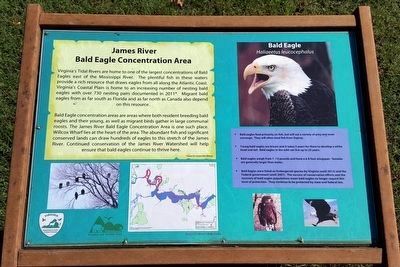
Photographed By Bernard Fisher, October 11, 2015
5. James River Bald Eagle Concentration Area
Virginia's Tidal Rivers are home to one of the largest concentrations of Bald Eagles east of the Mississippi River. The plentiful fish in these waters provide a rich resource that draws eagles from all along the Atlantic Coast. Virginia's Coastal Plain is home to an increasing number of nesting bald eagles with over 730 nesting pairs documented in 2011*. Migrant bald eagles from as far south as Florida and as far north as Canada also depend on this resource.
Bald Eagle concentration areas are areas where both resident breeding bald eagles and their young, as well as migrant birds gather in large communal roosts. The James River Bald Eagle Concentration Area is one such place. Willcox Wharf lies at the heart of the area. The abundant fish and significant conserved lands can draw hundreds of eagles to this stretch of the James River. Continued conservation of the James River Watershed will help ensure that bald eagles continue to thrive here.
• Bald eagles feed primarily on fish, but will eat a variety of prey and even scavenge. They will often steal fish from Osprey.
• Young bald eagles are brown and it takes 5 years for them to develop a white head and tail. Bald eagles in the wild can live up to 25 years.
• Bald eagles weigh from 7-14 pounds and have a 6-8 foot wingspan – females are generally large than males.
• Bald Eagles were listed an Endangered species by Virginia (until 2013) and the Federal government (until 2007). The success of conservation efforts and the recovery of bald eagles populations mean bald eagles no longer require this level of protection. They continue to be protected by state and federal law.
Bald Eagle concentration areas are areas where both resident breeding bald eagles and their young, as well as migrant birds gather in large communal roosts. The James River Bald Eagle Concentration Area is one such place. Willcox Wharf lies at the heart of the area. The abundant fish and significant conserved lands can draw hundreds of eagles to this stretch of the James River. Continued conservation of the James River Watershed will help ensure that bald eagles continue to thrive here.
• Bald eagles feed primarily on fish, but will eat a variety of prey and even scavenge. They will often steal fish from Osprey.
• Young bald eagles are brown and it takes 5 years for them to develop a white head and tail. Bald eagles in the wild can live up to 25 years.
• Bald eagles weigh from 7-14 pounds and have a 6-8 foot wingspan – females are generally large than males.
• Bald Eagles were listed an Endangered species by Virginia (until 2013) and the Federal government (until 2007). The success of conservation efforts and the recovery of bald eagles populations mean bald eagles no longer require this level of protection. They continue to be protected by state and federal law.
Also see . . . Captain John Smith Chesapeake National Historic Trail. National Park Service (Submitted on October 12, 2015.)
Credits. This page was last revised on August 25, 2016. It was originally submitted on October 12, 2015, by Bernard Fisher of Richmond, Virginia. This page has been viewed 478 times since then and 15 times this year. Photos: 1, 2, 3, 4, 5. submitted on October 12, 2015, by Bernard Fisher of Richmond, Virginia.
